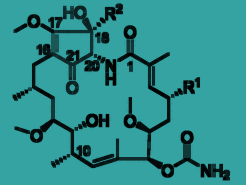Previously Unknown Microbial Natural Products
Digging around in the dark can sometimes lead to interesting results: in the acidic waters of an abandoned coal mine in Kentucky, USA, researchers discovered ten previously unknown microbial natural products from a strain of Streptomyces. They have now introduced these compounds in the journal Angewandte Chemie. Four of the molecules contain a cyclopentenone ring, which is rare in this class of substances.
The team led by Khaled A. Shaaban and Jon S. Thorson at the University of Kentucky’s Center for Pharmaceutical Research and Innovation, Lexington, USA, is part of a broader new initiative focused on mining-associated environments in Appalachian Kentucky. The goal is to seek out new organisms that produce previously unknown metabolites that could be potential starting materials for pharmaceutical development.
Geldanamycins and Ansamycins
The team has discovered previously unknown metabolites of a strain of Streptomyces in the abandoned underground Rock Creek coal mine in McCreary County. These compounds belong to the family of ansamycins, compounds that contain an aromatic ring system bridged by a long, aliphatic chain. The geldanamycins (Gdm) are a subset of the ansamycins whose aromatic ring consists of a quinone group, a six-membered ring of carbons with two double bonds and two oxygen atoms attached by double bonds. Gdm inhibits heat shock protein 90 (Hsp 90), a protein important for cell survival. Various Gdm analogs are in clinical use as antitumor drugs.
Characterization of the new compounds revealed that six of them are previously unknown geldanamycin variants. Four others are a new type of ansamycin: Instead of an aromatic ring, they have a cyclopentenone group, a ring of five carbons with a double bond and one oxygen atom bound by a double bond.
The new compounds (pictured) were named McCrearamycins after their county of origin. The researchers speculate that Gdms could be precursors of the McCrearamycins. Experiments with Gdms and model substances revealed that the quinone group can easily be converted to a cyclopentenone via a benzylic acid rearrangement. This could be a new synthetic route for the production of cyclopentenone derivatives.
Heat Shock Protein 90 Activity
Along with three known Gdm derivatives, the new compounds were tested for their ability to inhibit Hsp 90 and to probe their cytotoxicity against a line of cancer cells. The two did not correlate in all cases. It is clear that small structural variations can give rise to differences in cell uptake and/or different cytotoxicity mechanisms. This is worth examining further in the development of new pharmaceuticals.
In collaboration with S. Randal Voss and UK’s Ambystoma Genetic Stock Center, researchers also validated a new test for the activity of Hsp 90. The Mexican axolotl (Ambystoma mexicanum) is able to regenerate damaged limbs. Hsp 90 plays an important role in this process. In the presence of massive doses of Gdm, the amputated tails of axolotl embryos were not able to regenerate. High doses also caused developmental abnormalities. Gdm is thus useful for investigating the role of Hsp 90 in regeneration processes, and the test is useful in the search for Hsp 90 modulators
- Mccrearamycins A–D, Geldanamycin-Derived Cyclopentenone Macrolactams from an Eastern Kentucky Abandoned Coal Mine Microbe,
Xiachang Wang, Yinan Zhang, Larissa V. Ponomareva, Qingchao Qiu, Ryan Woodcock, Sherif I. Elshahawi, Xiabin Chen, Ziyuan Zhou, Bruce E. Hatcher, James C. Hower, Chang-Guo Zhan, Sean Parkin, Madan K. Kharel, S. Randal Voss, Khaled A. Shaaban, Jon S. Thorson,
Angew. Chem. Int. Ed. 2017.
DOI: 10.1002/anie.201612447




